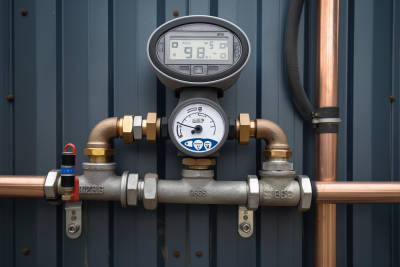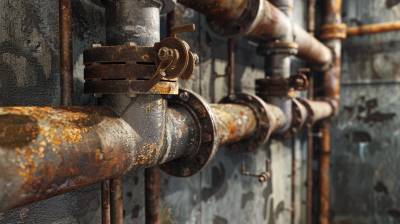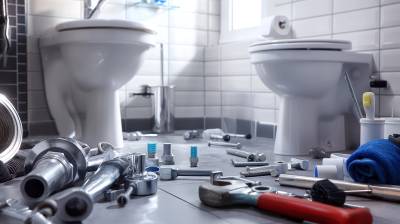Plumbing plays an essential role in our daily lives, yet it's a system that often goes unnoticed, unless there is trouble. One crucial aspect of this important system is the type of pipe used. Galvanized plumbing pipes are a type that has been traditionally used in many homes and buildings. A clear understanding of galvanized pipes, their usage, advantages, and the issues associated with them can help homeowners manage their plumbing infrastructure effectively.
Understanding Galvanized Plumbing Pipes
Galvanized plumbing pipes are iron pipes that have been coated with a layer of zinc. This galvanization process was implemented as a protective measure to prevent rust and corrosion. These pipes were commonly installed in homes before the 1960s. However, the use of these pipes has significantly declined due to emerging issues over time.
How Are Galvanized Pipes Made?
Iron or steel pipes are dipped in a bath of molten zinc, which forms a protective layer on the surface of the pipe. This process is known as "hot-dip galvanization". The protective zinc layer serves to guard the metal against damaging oxidation reactions.
The Complexities of Galvanized Plumbing Pipes
The use of galvanized pipes was popular due to their durability and cost-effectiveness. However, over time some issues arise, mainly due to the inherent characteristics of the zinc coating and the reacting nature of the galvanized pipes with the constituents of the water.
Step by Step Deterioration
-
The zinc layer on the galvanized pipe is designed to corrode over time, preventing the underlying iron or steel from rusting.
-
The deterioration process is usually slow, but over several decades, it leads to the zinc layer thinning and exposing the underlying pipe to water.
-
Once the iron or steel pipe is exposed to water, it begins to rust and corrode, leading to a reduction in the pipe's diameter due to the accumulation of rust inside.
-
This accumulation of rust leads to a reduced water flow and pressure, which can become problematic over time.
Issues With Water Quality
Another concern associated with galvanized plumbing pipes is the potential contamination of tap water. An aged galvanized pipe can have accumulated layers of rust on its inner surface. This rust can flake off and find its way into the tap water, leading to a cloudy, metallic-tasting water. Not only is this unpleasant, but there are potential health risks as well. Prolonged ingestion of high levels of rust particles can lead to health complications.
Replacing Galvanized Pipes
Given their shortcomings, individuals with galvanized plumbing systems in their homes or buildings may contemplate replacing them. When it comes to replacements, there are several alternatives available, including copper, PVC, and PEX piping.
When to Consider Pipe Replacement
If your home has galvanized pipes and you're experiencing low water pressure, consistent plumbing leaks, or water discoloration, these could be signs that the pipes are deteriorating and it might be time to consider a replacement. Another instance when homeowners might want to consider replacing galvanized plumbing pipes is during home remodeling or renovation projects.
Choosing the Right Replacement Pipes
There are several different materials available in the market for replacing galvanized plumbing pipes. Your choice should be based on factors such as:
- The type of plumbing system in your home
- The extent and location of replacement required
- Your budget and personal preferences
Professional Assistance for Dealing with Galvanized Pipes
Due to the technicalities, risk factors, and complexities associated with galvanized plumbing pipes, special consideration and expertise are required. Therefore, hiring professional plumbers who have comprehensive knowledge and experience with galvanized pipes can be immensely helpful. They can conduct a thorough examination of the plumbing situation, identify issues promptly, and recommend the best solution to avoid any long-term problems.
While galvanized plumbing pipes have played a significant role in the plumbing sector, an understanding of their complexities is vital for any homeowner. This knowledge will help in better maintenance and decision-making when issues with these pipes arise.
Frequently Asked Questions About Galvanized Plumbing Pipes
Why are galvanized plumbing pipes used?
Galvanized plumbing pipes are largely utilized due to their durability and rust-resistance characteristics. They are coated with a layer of zinc that helps prevent corrosion. This makes them especially beneficial in areas where there's a lot of moisture, ensuring the longevity of your plumbing system.
How long do galvanized plumbing pipes typically last?
On average, galvanized pipes can last between 20 to 50 years depending upon the water quality and environmental conditions. However, it's recommended to have an inspection every couple of years to ascertain their condition, as they can degrade over time and may need replacement.
How can one identify galvanized plumbing pipes?
Identifying galvanized pipes can be done by looking at their color. They typically have a gray or silver finish. Additionally, they are magnetic. So, one method to confirm if a pipe is galvanized is to see if a magnet sticks to it. If it does, there's a good chance the pipe is galvanized.
Are galvanized plumbing pipes safe?
While galvanized pipes were a popular choice for many years due to their rust resistance, they are known to eventually accumulate rust and corrosion on the interior over time. This can potentially lead to unsafe drinking water, depending on the degree of rusting, and so may require replacement.
Can galvanized plumbing pipes be repaired?
Yes, galvanized pipes can be repaired, often through a process called re-piping. This involves replacing the damaged sections of the pipe instead of replacing the entire system. But keep in mind, the newer sections of pipe might make any remaining old pipe degrade faster due to the contrast in pressure levels.
Does homeowners insurance cover galvanized plumbing pipes?
Most homeowners insurance policies do not cover the cost of replacing galvanized pipes. They usually only cover sudden and unexpected damage, but not wear-and-tear or degradation over time. It's recommended to check with your insurance provider for specific details.
How to maintain galvanized plumbing pipes?
Regular inspections and cleaning can help maintain your galvanized pipes. Inspections can highlight any trouble spots or potential problems early on. Cleaning can help remove excess rust and residue that may accumulate over time. If you notice a significant amount of rust or other signs of degradation, it may be time to consider replacing your pipes.
Can galvanized pipes carry hot water?
Yes, galvanized pipes can certainly carry hot water. In fact, they were commonly used for this purpose in homes until the mid 20th century. However, over time, the hot water can accelerate the rusting process, so they may not be the best choice for this purpose in the long term.
Can PVC pipes replace galvanized ones?
Yes, PVC pipes can be used as a replacement for galvanized pipes. They are easier to work with, don’t rust over time, and are often cheaper. However, they are not as sturdy as galvanized pipes and might not be suitable for handling high-pressure water in some cases.
Are galvanized pipe fittings reusable?
Although it's possible to remove and reuse galvanized pipe fittings, it's not generally recommended. Over time, the threads can become damaged and may lead to leaks. If you do reuse galvanized pipe fittings, be sure to check thoroughly for evidence of leaks.
Pros of Galvanized Plumbing Pipes
Longevity
-
One of the major advantages of galvanized plumbing pipes is their longevity. These pipes are extremely durable and can last for nearly 50 to 70 years if properly maintained. This makes them a cost-effective option for long-term plumbing needs.
-
The galvanization process equips the pipes with a zinc coating, which provides an extra layer of protection against rust and corrosion, increasing the lifespan of the pipe.
Protection Against Rust and Corrosion
-
Thanks to the zinc coating that is provided during the galvanization process, galvanized pipes are highly resistant to rust and corrosion. This is particularly beneficial for plumbing systems installed in areas with high moisture or humidity levels, as it eliminates the risk of water contamination due to rust.
-
Due to the anti-rust properties, the functionality and aesthetics of galvanized plumbing pipes remain intact for a long period.
Cost-Effective
-
Galvanized plumbing pipes provide good value for money given their longevity. Since these pipes are less prone to rust and leaks, they also save costs on maintenance and replacements in the long run.
-
They are relatively cheaper compared to copper or PEX piping, making them a popular choice for large scale plumbing projects and for homeowners on a tight budget.
Cons of Galvanized Plumbing Pipes
Lead Contamination
-
Older galvanized pipes were made using a technique that may have exposed the water to lead. Over time, the zinc lining can erode, exposing the iron pipe, which can then rust and release lead into the water supply. This is a major disadvantage and a potential health concern, especially in old houses which still have such plumbing systems installed.
-
As per the Environmental Protection Agency (EPA), exposure to lead can result in various health issues including developmental problems in children, kidney issues, and high blood pressure in adults. Therefore, many homeowners opt to replace vintage galvanized pipes to improve their water quality.
Corrosion and Clogging
-
Despite the rust-resistant zinc coating, galvanized plumbing pipes can still corrode over time. The corrosion tends to be internal which restricts the water flow due to the formation of rust on the pipe's interior. This could lead to lower water pressure or blockages, causing inconvenience to homeowners.
-
The zinc coating of galvanized pipes also slowly deteriorates over time. As this protective layer wears off, the iron underneath becomes exposed and susceptible to rust, which could eventually clog the water lines.
Limited Flexibility
-
Galvanized plumbing pipes are known for their rigidity and lack of flexibility. Therefore, installation or modification may require professional assistance. Unlike PEX or PVC pipes, it's difficult to maneuver galvanized pipes through tight spaces or around corners without using additional fittings.
-
Moreover, any substantial changes to the plumbing system may need major work or re-piping, which could be a costly affair.
Summary
Let's sum up what we've learned about galvanized plumbing pipes. These pipes were an integral part of many older homes, providing water delivery and sink drainage. You now know why they've fallen out of favor in modern homes in preference for copper or PEX, primarily due to their tendency for internal rusting and corrosion build-up, potentially impacting water quality. However, as long as these pipes remain structurally sound, they can continue to function with acceptable performance.
Awareness about the potential health risks associated with galvanized plumbing pipes should lead homeowners, especially those in older homes, not to ignore any signs of possible deterioration. Regular inspections should be a priority to identify and replace any pipes that show signs of corrosion. We've also discussed alternatives, like using copper or PEX, which have proved to be much safer and efficient.
When it comes to replacing your home's old galvanized plumbing pipes, it's crucial to consider the factors unique to your situation. Every home is different, and a plumbing solution suited for one may not be ideal for another. Understanding the pros and cons, the costs involved, and the lifespan of your existing pipes is an essential part of making the right decision. Don't hesitate to consult with a professional plumber who can guide you through this process.
About West Coast Hydronics & Plumbing
Welcome to West Coast Hydronics & Plumbing, your trusty plumbing ally based in sunny Sacramento, CA. We have proudly established an irreplaceable standing in our community thanks to our dedicated service and hands-on expertise in different aspects of hydronics and plumbing installation. From residential to commercial needs, there's no problem too big or too small for our talented team to solve. With us, what you get is not just a quick fix, but a long-term solution created with state-of-the-art tools and a wealth of knowledge. Get to know us better by checking out our work at our official website. We extend a hand of service to you with a promise of excellence and a genuine commitment to your satisfaction.








